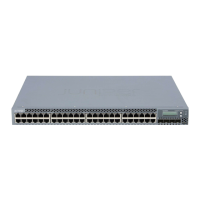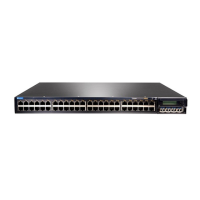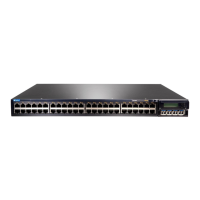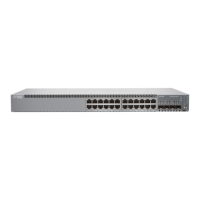that if an interface receives a packet, that interface does not match the forwarding table
entry as the best return path back to the source. If the receiving interface is not the best
return path to the source of a packet, unicast RPF causes the switch to discard the packet
even though it comes from a valid source.
Figure 4: Asymmetrically Routed Interfaces
NOTE: Do not enable unicast RPF on EX3200, EX4200, and EX4300 switches
if any switch interfaces are asymmetrically routed, because unicast RPF is
enabled globally on all interfaces of these switches. All switch interfaces
must be symmetrically routed for you to enable unicast RPF without the risk
of the switch discarding traffic that you want to forward.
Limitations of the Unicast RPF Implementation on EX3200, EX4200, and EX4300 Switches
On EX3200, EX4200, and EX4300 switches, the switch implements unicast RPF on a
global basis. You cannot enable unicast RPF on a per-interface basis. Unicast RPF is
globally disabled by default.
•
When you enable unicast RPF on any interface, it is automatically enabled on all switch
interfaces, including link aggregation groups (LAGs), integrated routing and bridging
(IRB) interfaces, and routed VLAN interfaces (RVIs).
•
When you disable unicast RPF on the interface (or interfaces) on which you enabled
unicast RPF, it is automatically disabled on all switch interfaces.
NOTE: You must explicitly disable unicast RPF on every interface on which
it was explicitly enabled or unicast RPF remains enabled on all switch
interfaces.
QFX switches and EX3200 and EX4200 switches do not perform unicast RPF filtering
on equal-cost multipath (ECMP) traffic. The unicast RPF check examines only one best
return path to the packet source, but ECMP traffic employs an address block consisting
of multiple paths. Using unicast RPF to filter ECMP traffic on these switches can result
in the switch discarding packets that you want to forward because the unicast RPF filter
does not examine the entire ECMP address block.
Related
Documentation
Example: Configuring Unicast RPF on an EX Series Switch•
• Configuring Unicast RPF (CLI Procedure) on page 97
Copyright © 2015, Juniper Networks, Inc.22
Network Interfaces for EX4300 Switches
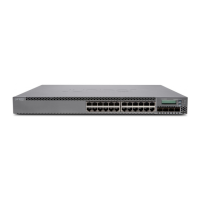
